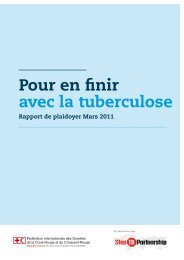new action plan lays the foundation for tb elimination - Stop TB ...
new action plan lays the foundation for tb elimination - Stop TB ...
new action plan lays the foundation for tb elimination - Stop TB ...
Create successful ePaper yourself
Turn your PDF publications into a flip-book with our unique Google optimized e-Paper software.
NEW ACTION PLAN LAYS THE FOUNDATION FOR <strong>TB</strong><br />
ELIMINATION<br />
Targets are realistic, but projected shortfall of US$ 4.2 billion per year <strong>for</strong> <strong>TB</strong> care<br />
and crucial research must be filled<br />
13 October 2010 - Johannesburg/Berlin/Geneva - The world could be on its way<br />
towards eliminating tuberculosis (<strong>TB</strong>) if governments and donors fully invest in a <strong>plan</strong><br />
released today by <strong>the</strong> <strong>Stop</strong> <strong>TB</strong> Partnership. The Global Plan to <strong>Stop</strong> <strong>TB</strong> 2011-2015:<br />
Trans<strong>for</strong>ming <strong>the</strong> Fight-Towards Elimination of Tuberculosis <strong>for</strong> <strong>the</strong> first time, identifies all<br />
<strong>the</strong> research gaps that need to be filled to bring rapid <strong>TB</strong> tests, faster treatment regimens<br />
and a fully effective vaccine to market. It also shows public health programmes how to<br />
drive universal access to <strong>TB</strong> care, including how to modernize diagnostic laboratories and<br />
adopt revolutionary <strong>TB</strong> tests that have recently become available.<br />
"There is an urgent need to scale up <strong>action</strong> against <strong>TB</strong> - 10 million people, including 4<br />
million women and children, will lose <strong>the</strong>ir lives unnecessarily between now and 2015 if<br />
we fail," says Dr Margaret Chan, Director-General of <strong>the</strong> World Health Organization<br />
(WHO), which hosts <strong>the</strong> <strong>Stop</strong> <strong>TB</strong> Partnership. "<strong>TB</strong> control works, with global incidence of<br />
<strong>the</strong> disease declining since 2004, although much too slowly."<br />
Twenty-two countries, including South Africa, bear 80% of <strong>the</strong> burden of <strong>TB</strong> worldwide.<br />
Some 9 million people become ill with active <strong>TB</strong> and nearly 2 million die each year. The<br />
<strong>new</strong> Global Plan sets out to provide diagnosis and treatment approaches recommended<br />
by <strong>the</strong> World Health Organization (WHO) <strong>for</strong> 32 million people over <strong>the</strong> next five years.<br />
"The Global Plan to <strong>Stop</strong> <strong>TB</strong> provides an urgently needed blueprint to cut global <strong>TB</strong><br />
deaths by half," says Dr Aaron Motsoaledi, Minister of Health of South Africa. "In South<br />
Africa we have embarked on an ambitious agenda <strong>for</strong> reducing <strong>the</strong> toll of <strong>TB</strong> on our<br />
people, and we are committed to meeting <strong>the</strong> Global Plan's targets. We call on world<br />
leaders to invest in <strong>the</strong> <strong>plan</strong>, which can help move us towards ridding <strong>the</strong> world of <strong>TB</strong>."<br />
Although <strong>TB</strong> is curable, <strong>the</strong> treatment requires taking a combination of drugs <strong>for</strong> at least<br />
six months. Laboratories in most countries are still using a century-old diagnostic method<br />
that involves searching <strong>for</strong> <strong>TB</strong> bacteria derived from a person's sputum under a<br />
microscope. And <strong>the</strong>re is still no vaccine able to prevent pulmonary <strong>TB</strong>, <strong>the</strong> most common<br />
<strong>for</strong>m of <strong>the</strong> disease.<br />
In addition to helping public health programmes adopt already existing modern diagnostic<br />
tests, <strong>the</strong> Global Plan sets a research agenda aimed at engendering two <strong>new</strong> "while-youwait"<br />
rapid tests that trained staff at even <strong>the</strong> most basic health outposts can use to<br />
diagnose <strong>TB</strong> accurately. By 2015, <strong>the</strong> aim is <strong>for</strong> three <strong>new</strong> drug regimens - one <strong>for</strong> drugsensitive<br />
<strong>TB</strong> and two <strong>for</strong> drug-resistant <strong>TB</strong> - to be going through Phase III clinical trials,
News Release WHO/28<br />
Page 2<br />
<strong>the</strong> final step be<strong>for</strong>e drugs are released to market. Four vaccine candidates should be at<br />
<strong>the</strong> same stage of testing.<br />
The Global Plan provides a clear roadmap <strong>for</strong> addressing drug-resistant <strong>TB</strong>. It calls <strong>for</strong> 7<br />
million people to be tested <strong>for</strong> multidrug-resistant <strong>TB</strong> (MDR-<strong>TB</strong>) and one million confirmed<br />
cases treated according to international standards over <strong>the</strong> next five years.<br />
Half a million people die each year from HIV-associated <strong>TB</strong>. Provided <strong>the</strong> <strong>plan</strong>'s targets<br />
are met, by <strong>the</strong> end of 2015, all <strong>TB</strong> patients will be tested <strong>for</strong> HIV and, if <strong>the</strong> test is<br />
positive, receive anti-retroviral drugs and o<strong>the</strong>r appropriate HIV care. In HIV treatment<br />
settings, all patients will be screened <strong>for</strong> <strong>TB</strong> and receive appropriate preventive <strong>the</strong>rapy or<br />
treatment as needed.<br />
On financing, <strong>the</strong> Global Plan calls <strong>for</strong> US$ 37 billion <strong>for</strong> implementation of <strong>TB</strong> care<br />
between 2011 and 2015. A funding gap of about US$ 14 billion - approximately $US 2.8<br />
billion per year - will remain and needs to be filled by international donors.<br />
The <strong>plan</strong> includes a separate calculation of <strong>the</strong> funding required to meet targets <strong>for</strong><br />
research and development: a total of US$ 10 billion, or $US 2 billion per year. Highincome<br />
countries and those with growing economies will need to increase <strong>the</strong>ir<br />
investment in research and development to fill an estimated gap of about US$ 7 billion, or<br />
$1.4 billion per year.<br />
In 2006 <strong>the</strong> <strong>Stop</strong> Partnership launched <strong>the</strong> Global Plan to <strong>Stop</strong> <strong>TB</strong> 2006-2015. The <strong>new</strong><br />
roadmap <strong>for</strong> 2011-2015 follows on that earlier <strong>plan</strong> while setting <strong>new</strong> and more ambitious<br />
targets <strong>for</strong> <strong>the</strong> next five years.<br />
The <strong>Stop</strong> <strong>TB</strong> Partnership, which is hosted by <strong>the</strong> World Health Organization in Geneva, Switzerland,<br />
consists of more <strong>the</strong>n 1200 international organizations, countries, donors from <strong>the</strong> public and private<br />
sectors, and nongovernmental and governmental organizations, all working toge<strong>the</strong>r to eliminate <strong>TB</strong>.<br />
Media contact:<br />
Judith Mandelbaum-Schmid, Email: schmidj@who.int, Mobile: +41 79 254 68 35.<br />
Broadcasters: B-roll will be available on www.global-<strong>plan</strong>-to-stop-<strong>tb</strong>.tv.<br />
All WHO in<strong>for</strong>mation can be found at: www.who.int



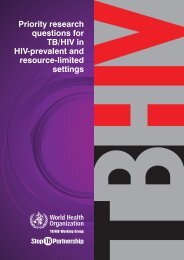
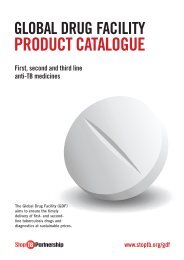
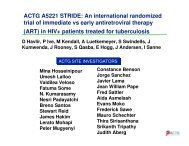
![Global Drug Facility Annual Report 2011 [.pdf] - Stop TB Partnership](https://img.yumpu.com/26788745/1/184x260/global-drug-facility-annual-report-2011-pdf-stop-tb-partnership.jpg?quality=85)

![Concept note on national stop TB partnership [.pdf]](https://img.yumpu.com/26788741/1/184x260/concept-note-on-national-stop-tb-partnership-pdf.jpg?quality=85)
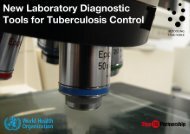

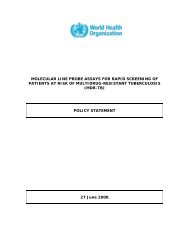
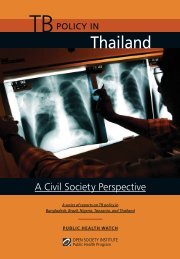
![2005 and Challenges for 2006 - 2015 [.pdf] - Stop TB Partnership](https://img.yumpu.com/26788674/1/190x245/2005-and-challenges-for-2006-2015-pdf-stop-tb-partnership.jpg?quality=85)
![Brochure (French) [.pdf] - Stop TB Partnership](https://img.yumpu.com/17234792/1/190x91/brochure-french-pdf-stop-tb-partnership.jpg?quality=85)

